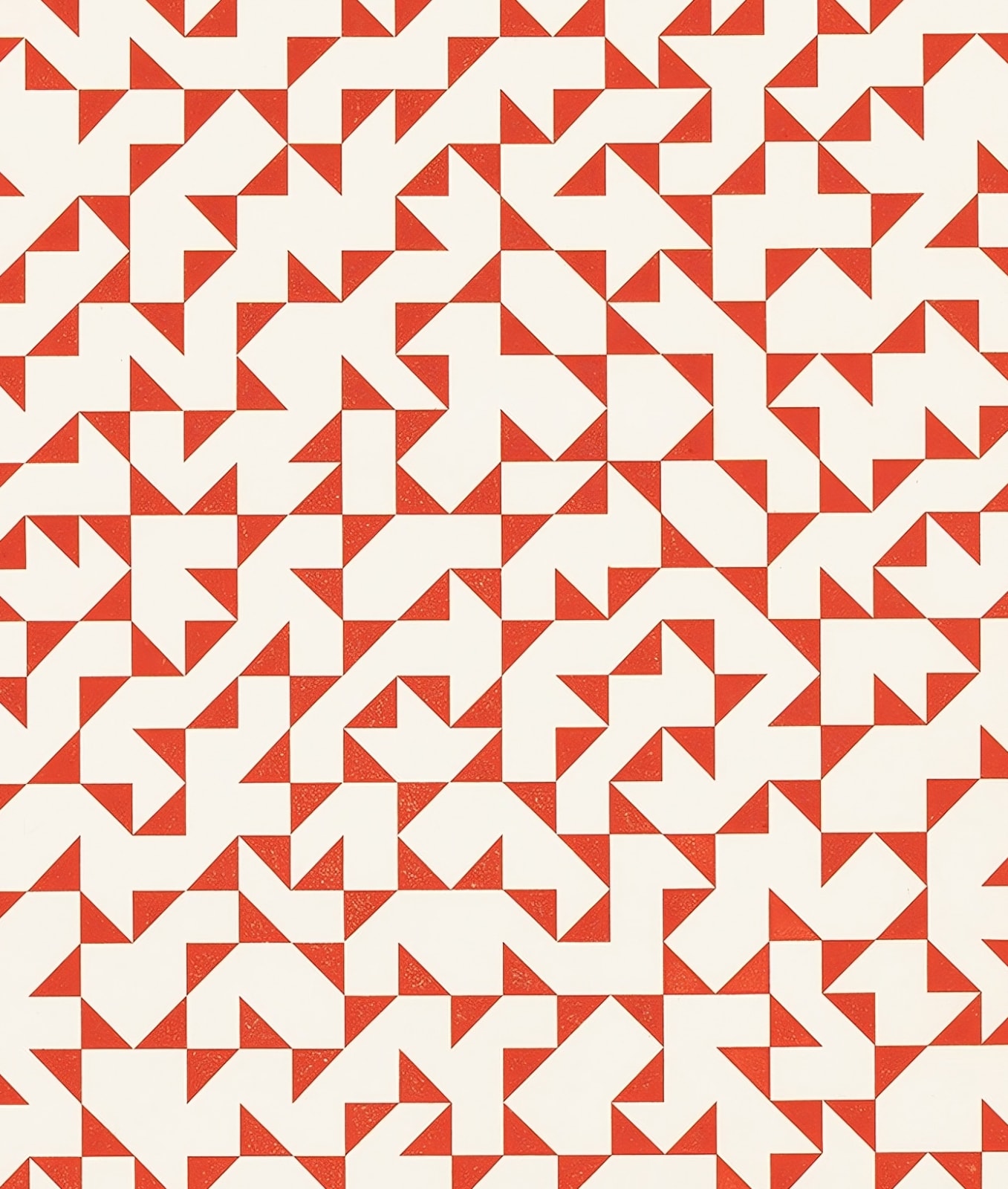Anni Albers
In Triangulated Intaglio IV, Anni Albers reaffirms her position not only as a central figure in the history of modernist abstraction, but as a thinker who approached visual composition as both material construction and metaphysical proposition. Executed in 1976, this intaglio print is a paradigmatic example of her late graphic work, where textile logic, architectural rigor, and an intuitive sense of rhythm converge. Unlike the more atmospheric stippling of Triangulated Intaglio I, this fourth iteration moves decisively toward a more assertive language of interlocking forms and chromatic presence.
Visually, Triangulated Intaglio IV presents a gridded field populated by red triangular modules that appear to rotate, tessellate, and pivot across the plane in unpredictable sequences. The color is unmodulated—a vivid, primary red—which grants the work a boldness that is atypical in Albers's more understated early palette but consistent with her Bauhaus-era belief in the communicative potential of color. There is a musicality to the distribution: an optical syncopation, as if each shape were a note in a silent score, each rotation a pause, accent, or shift in key. The surface does not lie still. It pulses.
What distinguishes this work within Albers’s oeuvre is its synthesis of systemic order and visual play. There is no central motif, no obvious hierarchy. Instead, the structure emerges through repetition and variation, a compositional strategy drawn directly from her decades-long engagement with weaving. Yet here, instead of thread, Albers manipulates metal and ink. Instead of warp and weft, she utilizes the binary tension of figure and ground. The result is a composition that feels both ancient and futuristic, as if borrowing from the logic of pre-Columbian patterning while also anticipating the algorithmic structures of digital aesthetics.
Conceptually, Triangulated Intaglio IV offers a meditation on transformation and iteration. The individual triangle—a form Albers revered for its inherent dynamism—is treated not as a static unit but as a hinge between states. Their rotations and mirrorings suggest a system in flux, a formal vocabulary that can generate infinite permutations from finite means. This speaks not only to Albers’s deep Bauhaus inheritance but to her personal philosophy of art as a disciplined freedom: the liberation that comes not from the absence of rules, but from the creative intelligence to reconfigure them.
Positioned in the broader arc of her career, this work reflects the culmination of a lifelong inquiry into the intersection of tactility and abstraction. In turning to intaglio in the 1970s, Albers was not abandoning her textile practice but translating its principles into a new idiom. Printmaking—particularly intaglio—offered her a mode of precision and repeatability that mirrored the loom while enabling new compositional experiments. Triangulated Intaglio IV is not merely a print; it is a woven proposition rendered in ink and impression, bridging centuries-old techniques with modernist clarity.
Moreover, the work exemplifies Albers’s belief that art should engage both mind and body—that the act of looking should be active, embodied, and ever-evolving. The viewer’s eye is compelled to navigate the maze-like field, to trace symmetries and asymmetries, to become aware of perception itself as a kind of tactile experience. In this way, Triangulated Intaglio IV becomes more than an image: it becomes an invitation to inhabit a space of structured imagination. This print underscores Anni Albers’s singular achievement: to render abstraction intimate, to make geometry breathe, and to remind us that within every module—every dot, every line, every triangle—resides the potential for profound poetic expression.
Image: 13 x 12 in (33 x 30.5 cm)
Sheet: 24 x 20 in (61 x 50.8 cm)
This artwork is signed, dated and numbered in pencil, from the edition of 20, plus 9 artist's proofs.




